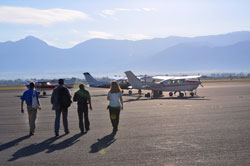Long-term vision for the Gallatin Range needed for both people and wildlife
By Kelsey Dzintars, explorebigsky.com staff writer
The communities of Bozeman, Big Sky, Livingston, Gardiner and West Yellowstone know the Gallatin Mountains as an exceptional outdoor recreation area. With 10,000-foot peaks, majestic canyons and internationally known “blue ribbon” trout streams, opportunities for hiking, biking, fishing, climbing, skiing, horseback riding, and motorized recreation abound.
The range is also a vital component in the Greater Yellowstone Ecosystem, one of few large, intact networks of wild lands left in North America. A designated Wilderness Study Area since 1977, the Gallatins still lack permanent protection.
With the populations of nearby towns and cities burgeoning, demand for fresh water and recreation use have both grown dramatically over the last 30 years. Many organizations are calling for the community of people around the Gallatins to come together to finally make a decision how to best protect this valued land before it’s too late.
One such group, The Wilderness Society, is working to highlight the wildlife piece of this puzzle to inform discussions about the future of the range.
“Up to this point much of the conversation has surrounded recreation,” said Jennifer Miller, The Wilderness Society’s Montana Program Manager. “We wanted to gain a better understanding of how wildlife use the area, to make informed decisions moving forward.”
To further this goal, The Wilderness Society commissioned a wildlife report of the area from biologist Steve Gehman, co-founder of Wild Things Unlimited in Bozeman, a nonprofit organization dedicated to increasing the effectiveness of wildlife and habitat management in the Rocky Mountains.
Gehman’s 40-page report, completed in December of 2010 and updated May 2012, gives detailed observations on the area’s species, and also the interests of land and wildlife management agencies and the conservation community. In it, he stresses that the Gallatin Range plays an important role in maintaining habitat connectivity.
“The northern end of the range forms a linkage to a major wildlife corridor that connects the Greater Yellowstone Ecosystem to the Northern Continental Divide Ecosystem,” he writes, naming the Gallatin-Bridger-Big Belt Corridor as a primary link.
Wildlife corridors are vital for large species requiring significant sized ranges, and also as connection corridors for smaller animals and plants, Gehman says.
The Gallatin Range is also key to linking habitat for wildlife at a continental scale, from Yellowstone National Park to Canada’s Yukon Territory. Stretching 1,988 miles, a link like this would conserve multiple species and allow gene flow between distant wildlife populations, say wildlife conservationists.
Grizzly bears, which remain on the endangered species list after a November 2011 9th Circuit ruling, are one species that need such a corridor.
After WTU research from 2006-2008 discovered an increased grizzly bear population in Tom Miner Basin, the group conducted surveys in the northern Gallatin Range in 2010 and 2011. Visual and laboratory analyses of hair samples concluded the range outside of Yellowstone National Park is now home to 28 grizzlies, 20 of which were bears identified in Tom Miner in the 2008 analyses.
In an interview with the Weekly, Gehman attributed this migration to food opportunities in these drainages not available inside the national park, and also to the widespread die-offs of whitebark pine in the Greater Yellowstone Ecosystem. The Gallatins and other ranges northwest of the park provide a diversity of forest that the animals need and use, he says.
“The most important issue is to keep an eye on our outdoor recreation usage and keep in mind what that means for wildlife,” Gehman said. “Be aware of the fact that we are pushing into wildlife area.”
Some organizations, such as the Citizens for Balanced Use, a coalition of motorized and mechanized recreationists, believe the current designated Wilderness Study Area is too restrictive. They say trail inventories in Montana show very little if any resource damage from off trail riding. Others add that surrounding tourism-based communities like Big Sky could economically benefit by opening up more trails for recreation opportunities.
The Wilderness Society hopes “a diverse group of people who enjoy the range for different reasons” can support further protection for the area, ensuring clean water and healthy wildlife habitat, while also allowing for increased recreational opportunities.
With the evidence of increasing wildlife presence closer to Montana cities, and outdoor recreation on the rise in these essential habitats, a need for permanent protection for the Gallatin Range has become ever more pressing, Miller said.
“There is no better time than now.”
A copy of Steve Gehman’s wildlife report can be downloaded from: gallatinwrp.org/wp/gallatin-range/library
EcoFlight
 This June, the Wilderness Society teamed up with EcoFlight to provide local journalists the opportunity to fly over the Gallatin Range with biologist Steve Gehman to learn more about the diverse and essential habitats of the area.
This June, the Wilderness Society teamed up with EcoFlight to provide local journalists the opportunity to fly over the Gallatin Range with biologist Steve Gehman to learn more about the diverse and essential habitats of the area.
EcoFlight pilot Bruce Gordon aims to educate others through the use of small aircraft and aerial perspective.
“I want people to get their own experience,” Gordon said. “I want them to learn.”
Conservation in the Gallatin Range is one of EcoFlight’s many projects. Learn more at ecoflight.org.
How to report wildlife observation data collected in the Gallatin Range
Wildlife data collected by citizens is an increasingly valuable resource for biologists and forest managers, especially if sufficient and specific information is included. The Wilderness and Recreation Partnership is particularly interested in observational data on wildlife that is less commonly seen. Data may be submitted online at:
gallatinwrp.org/wp/gallatin-range/wildlife-observation












